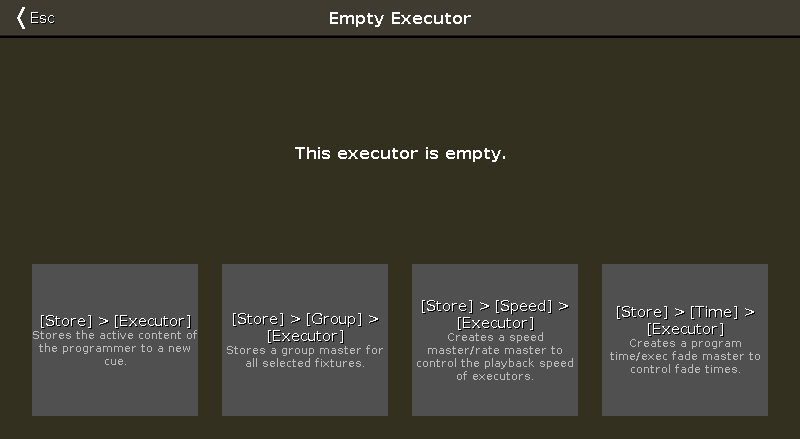Empty Executor Window
To get to the Empty Executor Window, tap an empty executor in the executor bar window.

Figure 1: Empty Executor Window
There are four executor options:
Store Executor:
Tap to store the active programmer values as a cue on the executor.
Store Group Executor:
Tap to store the selected fixture as a group master on the executor.
Store Speed Executor:
Tap to make this executor one of four speed masters or a rate master.
A speed master controls the speed of effects in cues and the playback speed of chasers.
The rate master multiplies the cue timing by the factor that was set by the rate master fader.
Store Time Executor:
Tap to make this executor as an executor time master or program time master.
The executor time master overrides cue fade, on/off times, and sets the cue delay to zero.
The program time master controls the fade times of all program values between 0 and 10 seconds.
This affects both, the adding of new values into the programmer, and the removing of values from the programmer with the Clear key.
To leave the Empty Executor Window, tap Esc in the title bar or press Esc on the console.
Example Store Executor
Let´s assume you store the active programmer values as a cue on the executor 1.
Figure 2: Executor with one cue
- Tap the empty executor 1 in the executor bar window. The empty executor window opens.
- Tap Store Executor.
The active program values are stored on executor 1 as cue 1.
Example Group Executor
Let´s assume you store the selected dimmer fixtures on the left side as a group master on the empty executor 6.
Figure 3: Group Master
- Select all dimmer fixtures on the left side in the fixtures view.
- Tap the empty executor 6 in the executor bar window. The empty executor window opens.
- Tap Store Group Executor.
The executor 6 is a group master.
Example Rate Executor
Let´s assume you apply a rate master on the empty executor 6.

Figure 4: Master Rate
- Tap the empty executor 6 in the executor bar window. The empty executor window opens.
- Tap Store Speed Executor.
The select master type window opens. - Tap Master Rate.
The executor 6 is a master rate.
Example Time Executor
Let´s assume you apply a program time master on the empty executor 1.
Figure 5: Program Time Master
- Tap the empty executor 1 in the executor bar window. The empty executor window opens.
- Tap Store Time Executor.
The select master type window opens. - Tap Prog Time.
The executor 1 is a program time master.




